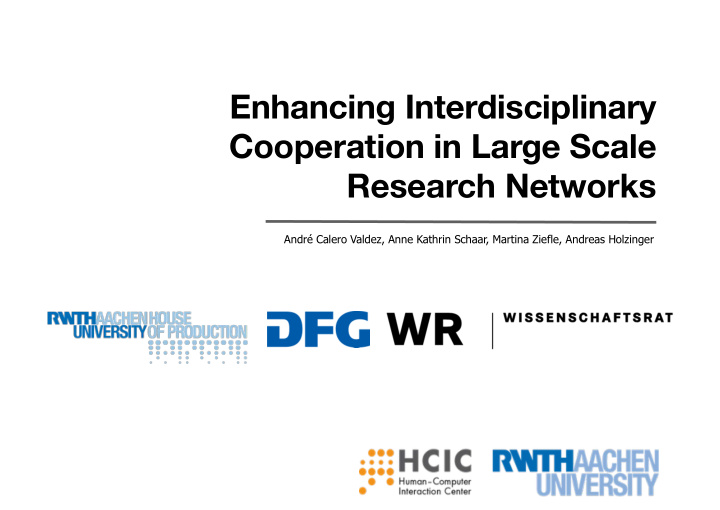



Enhancing Interdisciplinary Cooperation in Large Scale Research Networks André Calero Valdez, Anne Kathrin Schaar, Martina Ziefle, Andreas Holzinger
Agenda Overview “Interdisciplinary Innovation Management” 1 Investigating and supporting interdisciplinarity in research 2 clusters Study: Benefits and Barriers of a bibliometric visualization Lessons learned and outlook on future work 3
Research Background
Overview „Interdisciplinary Innovation Management“ Part of the CSP 1 Team: Scientific § cooperation Engineering Main research question: How can a § visualization instrument for cooperation contribute to ensuring success in interdisciplinary research teams? Underlying research questions : § – How can one measure scientific success in interdisciplinary teams? – Which means can support interdisciplinary cooperation? n Our approach: Combination of: User-centered design of a publication visualization – tool for steering, self-measurement and scientific analysis of interdisciplinary teams accompanying research in form of surveys, – interviews, user tests
Agenda Overview “Interdisciplinary Innovation Management” 1 Investigating and supporting interdisciplinarity in research 2 clusters Study: Benefits and Barriers a bibliometric visualization Lessons learned and outlook on future work 3
Example: State of the (Net)work Address (2012)
Example: Publication Node
Example: Author Node
Example: Discipline Node
Study Design § Semi-Structured Interview Study (n=22) § Researchers from the cluster § 4 parts – Validity of the approach in regard to interdisciplinary performance – Validity for steering – Evaluation of possible impacts – Evaluation in regard to self-measurement § Transcription § Quantitative Analysis (cf. Mayring)
Results Overview § 26 underlying concepts identified § 76 mentions positive § 63 mentions negative
Results - Pro Pro arguments for publication visualization approach retrospective analysis information regarding the team planning performance comparison tool for steering interdisciplinarity quick overview motivation to publish new information interdisciplinary tolerance grade bootlicking visualization of expertise and hierarchy can be used as an argumentation basis 0" 2" 4" 6" 8" 10" 12" 14" 16" Number'of'men+ons'
Results - Con Con$arguments$against$publica2on$visualiza2on$approach$ missing information negative influence on workflow bad legibility no statement about quality publications are just one aspect of performance too much scope for interpretation no change in performance no appropriate visualization distance between authors is steering a teams behaviour desirable? willingness for cooperation not clear publications outside the network not visible publishing ≠ functioning team (& vice versa) fake-authorship 0" 5" 10" 15" 20" 25" Number$of$men2ons$
Agenda Overview “Interdisciplinary Innovation Management” 1 Investigating and supporting interdisciplinarity in research 2 clusters Study: Benefits and Barriers a bibliometric visualization Lessons learned and outlook on future work 3
Lessons learned § Retrospective analysis of interdisciplinary efforts is possible § Researchers have differing views on bibliometric analysis § Accuracy and Privacy are high concerns § Fear of over-interpretation data § Teaching about bibliometric interpretation necessary => Workshops „Interdisciplinary Publishing
Thank you for your attention! Contact RWTH Aachen University, Human-Computer Interaction Center Campus-Boulevard 57 52074 Aachen, Germany Dipl.-Inform. André Calero Valdez Phone: +49 (0) 241/ 80 49239 E-Mail: calero-valdez@comm.rwth-aachen.de
Recommend
More recommend